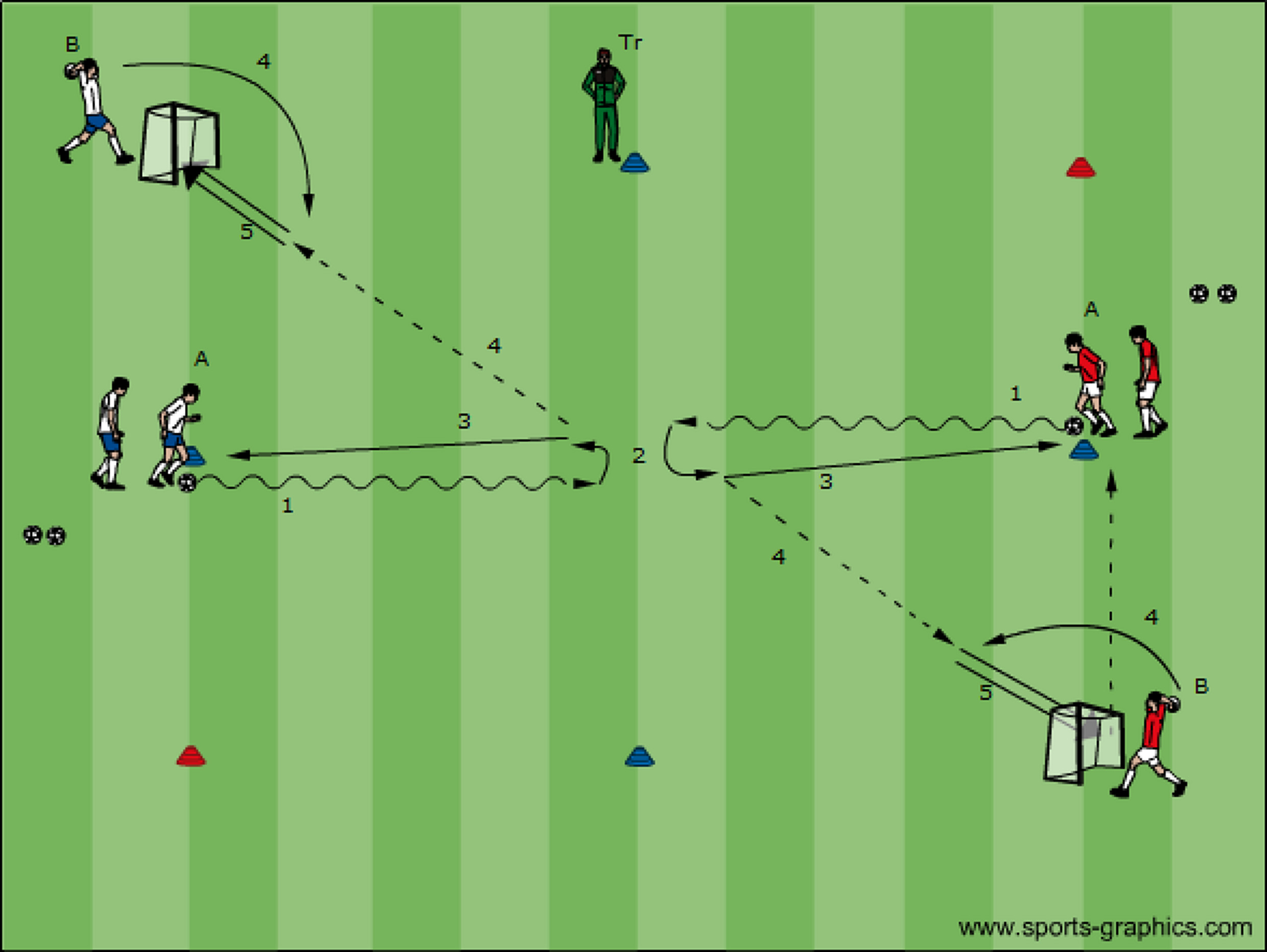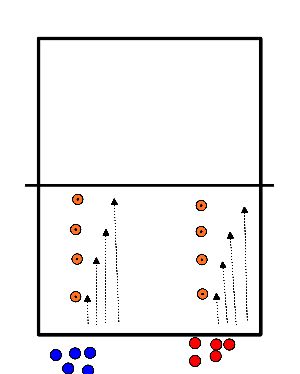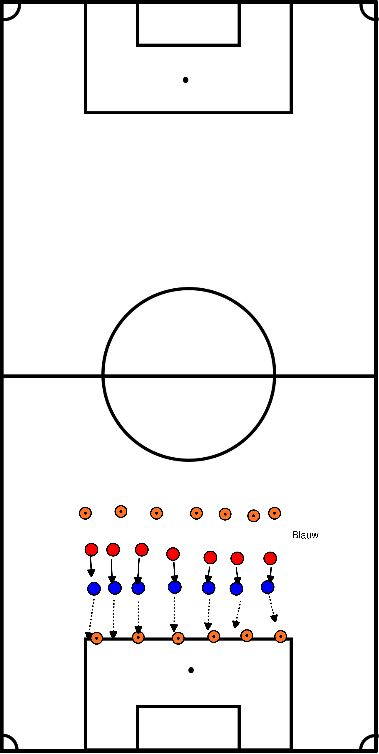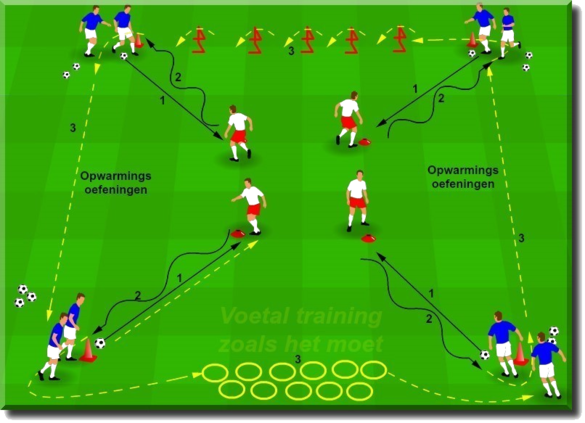Soccer drills for technique condition
Exercise1 RUN STRAIGHT FORWARD
- Jog to the last pylon.
- Make sure your upper body is upright.
- Your hips, knees and feet should form a line.
- Don't let your knees buckle inwards.
- On the way back, run a little faster.
- Do the exercise twice.
Exercise 2 RAISE KNEE AND TURN UPPER LEG OUTWARDS WHILE RUNNING
- Jog to the first pylon.
- Stop and raise your knee forward.
- Turn your knee out and put your foot down.
- Keep your pelvis horizontal and your upper body still.
- The hip, knee and foot of the supporting leg together form a straight line.
- Do not let the knee of the supporting leg bend inwards.
- Jog to the next pylon and repeat the exercise with the other leg.
- When you have finished the course, jog back. Do the exercise twice.
Exercise 3 RAISE KNEE AND TURN UPPER LEG INWARDS WHILE RUNNING
- Jog to the first pylon.
- Stop and raise your knee sideways.
- Turn your knee inwards and put your foot down.
- Keep your pelvis horizontal and your upper body still.
- The hip, knee and foot of the supporting leg together form a straight line.
- Do not let the knee of the supporting leg bend inwards.
- Jog to the next pylon and repeat the exercise with the other leg.
- When you have finished the course, jog back.
- Do the exercise twice.
Exercise 4 RUNNING AROUND A PARTNER
- Jog to the first pylon.
- Shuffle sideways, at an angle of 90 degrees to your partner, shuffle a whole circle around each other (without changing your direction of view).
- and back to the first pylon.
- Bend your hips and knees slightly and move your body weight to the ball of your feet.
- Do not let your knees bend inwards.
- Jog to the next pylon and repeat the exercise.
- When you have finished the course, jog back.
- Do the exercise twice.
Exercise 5 JUMP AND TOUCH SHOULDERS WHEN RUNNING
- Jog to the first pylon.
- Shuffle sideways, at an angle of 90 degrees to your partner.
- Jump in the middle towards each other to make shoulder to shoulder contact.
- Land on both feet with your hips and knees bent.
- Do not let your knees bend inwards.
- Shuffle back to the first pylon.
- Jog to the next cap and repeat the exercise.
- When you are ready with the course, jog back.
- Do the exercise twice.
Exercise 6 RUN ACCELERATING AND SLOWING DOWN
- Run quickly to the second pylon
- and then run backwards to the first pylon;
- keep your hips and knees slightly bent.
- Always run two pylons forward and one back.
- When you're done with the course, jog back.
- Do the exercise twice.
Set up your team in 2 lines (4-5 per line max) - only 1 ball needed.
IMPLEMENTATION:
- Players take the ball and then play it to the first person in the line opposite to them. Immediately after the pass they draw a sprint and close the back of the line they just played in. This is repeated over and over again.
QUALITY:
- Players are all on their toes ready for the pass.
- Passes are clear and accurate.
- Players must shout if they want the ball to play, and also shout the name to whom they are passing again.
- With the first ball contact they bring the ball under control, the second ball contact is the pass to the other player.
PROGRESS:
- Apply only one pass.
- Let one line pick up the ball and throw it back to the other line. They will then play the ball back with a volleypass and then simply join the other line.
- Let players take the ball with their thigh and bring it under control after which they pass the ball back over the ground.
- Place a pawn 5 meters on either side of the central point between the 2 lines. After the pass, the players have to walk around the pawn after which they connect in the row.
- Split your team into four teams of four
- 1 ball per team
IMPLEMENTATION:
- Players play the ball around within their team of four in the area that was put out
QUALITY:
- Players are constantly moving, with many tempo changes to find space.
- Each team must try to maintain a diamond shape
- Players must all communicate with teammates, the ball must be asked for and the player's name must be called by the person who is playing the ball.
- Passes should arrive well, in space or in the feet.
- Players should not touch each other, nor should the balls touch each other.
- This exercise requires great vigilance on the part of the players.
PROGRESS:
- Add a passive defender who can defend any ball.
- Add a defender who can conquer the ball.
For this fun and interactive soccer warm up you let the players make a circle around you, about 15 meters away from you. So you are standing in the middle of the circle.
IMPLEMENTATION:
- The starting point of the players is their place in the circle, they stay "jogging" in place.
- Call: "Inside" and all players sprint towards you up to a meter or two away. Then they turn around and quickly sprint back to their spot where they keep moving.
- Call: "Outside" and all players sprint away from you until you call "Back", then everyone returns to the starting position in the circle.
QUALITY:
- Make sure players do not stand on their flat feet, but always on their toes.
- Players should sweat heavily after this exercise.
PREVENTION:
- You can apply different variations: sit-ups, push-ups, jump up, knees up by base position, sprint to the right or left while maintaining the circle shape.

This exercise can be used for each category in the warm-up.
- Both players A lead the ball to the middle pilon where they perform a chop and then play the ball to the next player.
- After the pass, the player runs diagonally to player B who throws in the ball and players A heads it in the goal.
- The player that performed the header then takes the ball and stands behind goal,
- The other player joins the group that has to perform the movement
- Put two groups opposite to each other.
- The player in front passes the ball to the front of the other group and sprints to the other group and join them at the back.
- The person who receives the ball plays the ball back to the opposite group to the one who is then in front and joins them at the back.
- This repeats itself constantly and with good overplaying and sprinting it is a very active exercise.
- player sprints to the ball (A)
- he dribbles it to A1 where he leaves the ball.
- at a steady pace to the sideline to get back to A1.
- From A1, he sprints to the ball that is behind the pilon at A.
- He dribbles to A2 where he leaves the ball.
- So on to c2.
- The goalkeeper rolls the ball towards the goalkeeper and then finishes at goal. Try to take and shoot once.
- Make two groups.
- Set out a course with four pilons in a row. Distance between them about 3 meters.
- On signal the first one will sprint back and forth to the first pilon and back and further and further.
- At the last pilon back and tap the next one.
- Group that is back first is the winner.

- field 15 m wide.
- Make groups of three.
- Each player of a group goes either left, straight or in the middle.
- The player in the middle asks for the ball and plays it firmly to the other player
- Player in the middle turns and asks for the ball again but on the other side.
- 1m full on and then switch.
- all players on the left get the ball.
- Player 2 runs in and asks for the ball.
- Player 1 plays in and gets it right back.
- Player 2 runs around the pilon and asks for the ball again.
- Change role after 10 times.
- Inside
> heads
>inside high
>knee
difficult
let them walk out after they've played the ball.
- Make two rows of players. Give the rows a colored jacket.
- For example blue and yellow.
- Place the rows opposite each other at a distance of about three meters.
- At about 5 meters behind the rows is a line made with hats.
- On command yellow or blue, the colour concerned sprints to the line behind it and must tap the other colour.

- The 4 groups start at the same time with one ball each
Group 1:
A plays to B and takes the place of B.
B controls the ball and dribbles to C,
when he gets to C, he gives the ball to C,
...who's restarting the exercise.
A runs towards and goes through the hoops,
Join group 2
Group 2.
Group 2: Same as group 1,
to group 3 with warm-up exercises.
Group 3:
Same as group 1,
to group 4 over or through the hedges.
Group 4:
Same as group 1,
to group 1 with warm-up exercises.








